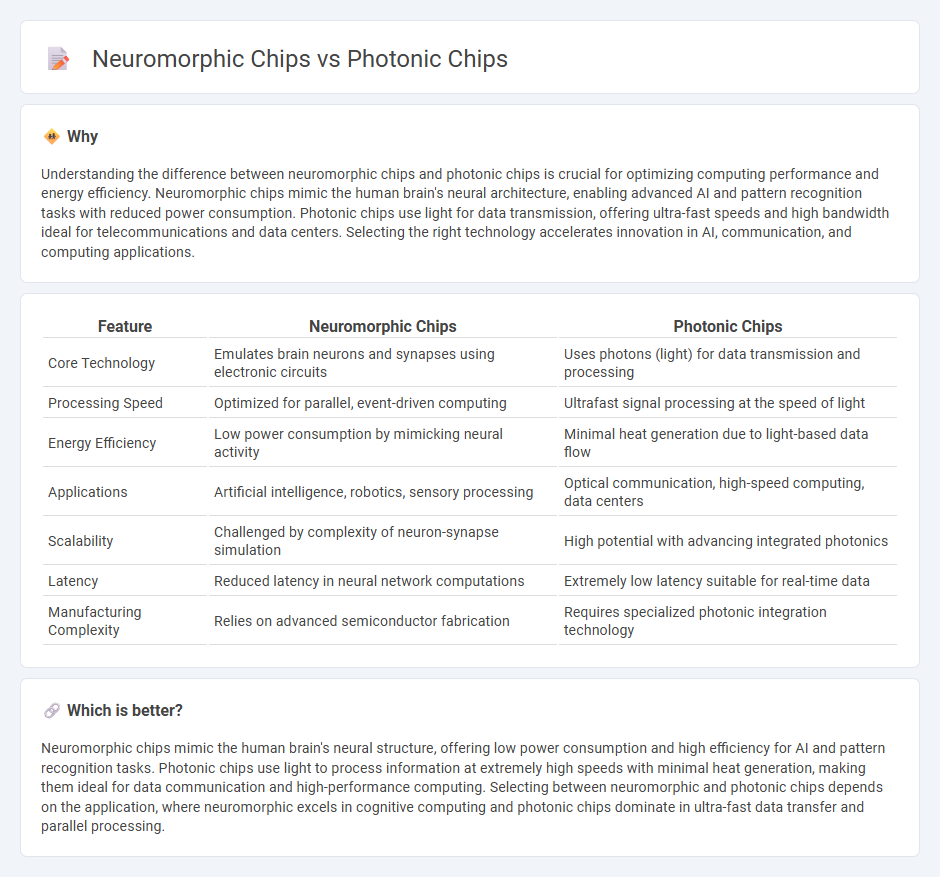
Neuromorphic chips mimic the neural architecture of the human brain, enhancing machine learning efficiency and reducing power consumption by processing information through spiking neurons. Photonic chips leverage light particles to transmit data at unparalleled speeds with minimal heat generation, revolutionizing high-speed computing and communication systems. Discover how these cutting-edge technologies are reshaping the future of computing.
Why it is important
Understanding the difference between neuromorphic chips and photonic chips is crucial for optimizing computing performance and energy efficiency. Neuromorphic chips mimic the human brain's neural architecture, enabling advanced AI and pattern recognition tasks with reduced power consumption. Photonic chips use light for data transmission, offering ultra-fast speeds and high bandwidth ideal for telecommunications and data centers. Selecting the right technology accelerates innovation in AI, communication, and computing applications.
Comparison Table
| Feature | Neuromorphic Chips | Photonic Chips |
|---|---|---|
| Core Technology | Emulates brain neurons and synapses using electronic circuits | Uses photons (light) for data transmission and processing |
| Processing Speed | Optimized for parallel, event-driven computing | Ultrafast signal processing at the speed of light |
| Energy Efficiency | Low power consumption by mimicking neural activity | Minimal heat generation due to light-based data flow |
| Applications | Artificial intelligence, robotics, sensory processing | Optical communication, high-speed computing, data centers |
| Scalability | Challenged by complexity of neuron-synapse simulation | High potential with advancing integrated photonics |
| Latency | Reduced latency in neural network computations | Extremely low latency suitable for real-time data |
| Manufacturing Complexity | Relies on advanced semiconductor fabrication | Requires specialized photonic integration technology |
Which is better?
Neuromorphic chips mimic the human brain's neural structure, offering low power consumption and high efficiency for AI and pattern recognition tasks. Photonic chips use light to process information at extremely high speeds with minimal heat generation, making them ideal for data communication and high-performance computing. Selecting between neuromorphic and photonic chips depends on the application, where neuromorphic excels in cognitive computing and photonic chips dominate in ultra-fast data transfer and parallel processing.
Connection
Neuromorphic chips mimic the architecture of the human brain through spiking neural networks, enabling efficient processing of complex data patterns. Photonic chips use light-based components to transmit and process information at speeds much faster than traditional electronic circuits. Integrating photonic technology with neuromorphic computing leverages both ultra-fast data transfer and brain-inspired processing, advancing AI performance and energy efficiency.
Key Terms
Optical Interconnects (Photonic Chips)
Photonic chips leverage optical interconnects that use light to transmit data with ultra-high bandwidth and low latency, significantly outperforming electronic counterparts in speed and energy efficiency. These optical interconnects reduce heat generation and signal loss, enabling faster data communication within and between chips, crucial for applications in data centers and high-performance computing. Explore deeper into how photonic chip technology revolutionizes data transmission and its impact on future computing architectures.
Spiking Neural Networks (Neuromorphic Chips)
Neuromorphic chips are specifically designed to emulate the architecture and functionality of biological neural networks using Spiking Neural Networks (SNNs), which process information through discrete spikes similar to neuron firing. Photonic chips leverage light-based signal transmission to achieve ultra-fast data processing and low energy consumption but typically do not replicate the spiking behavior critical for SNNs. Explore the technical distinctions and potential applications of these cutting-edge technologies to understand their impact on AI advancements.
Parallel Processing
Photonic chips leverage light-based signals to achieve ultra-fast parallel processing with minimal heat generation, enabling high bandwidth and low latency data transmission in neural network applications. Neuromorphic chips mimic brain-like architectures using spiking neurons and synapses to perform energy-efficient, massively parallel computations tailored for cognitive tasks. Explore the distinct advantages and use cases of photonic and neuromorphic chips for advanced parallel processing.
Source and External Links
What is a Photonic Integrated Circuit (PIC) and How Does It Work? - Photonic chips, or photonic integrated circuits (PICs), use photons passing through optical components like waveguides and lasers instead of electrons, enabling miniaturization, higher speed, low heat, and broad applications from data communication to sensing.
Photonic integrated circuit - Wikipedia - A photonic chip integrates multiple photonic components to generate, transport, and process light, commonly using indium phosphide material, and has evolved from simple lasers to complex circuits with hundreds of functions on one chip.
Are Photonic Chips Better than Silicon Chips? - AZoOptics - Photonic chips process information at the speed of light, up to 100 times faster than silicon chips, with lower power consumption and heat generation, promising advances in fields like AI, data centers, and medical imaging.
 dowidth.com
dowidth.com